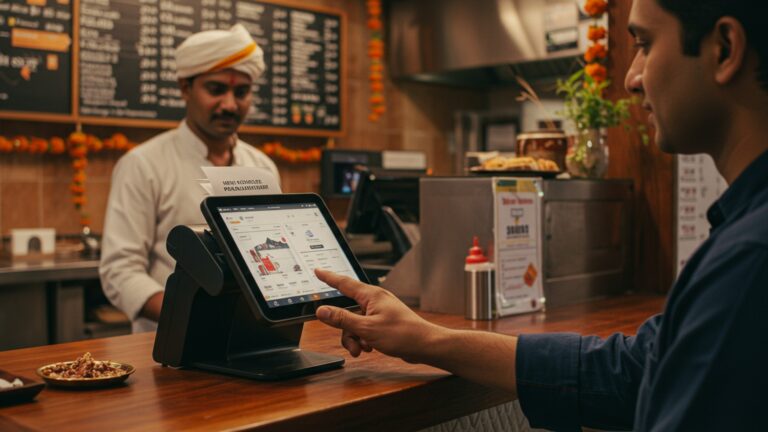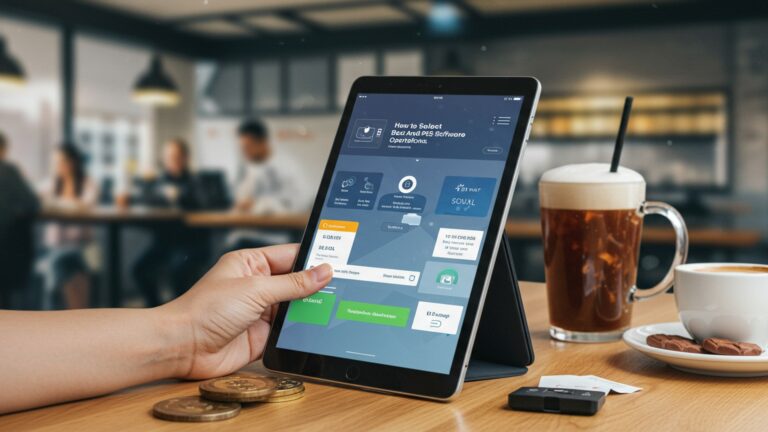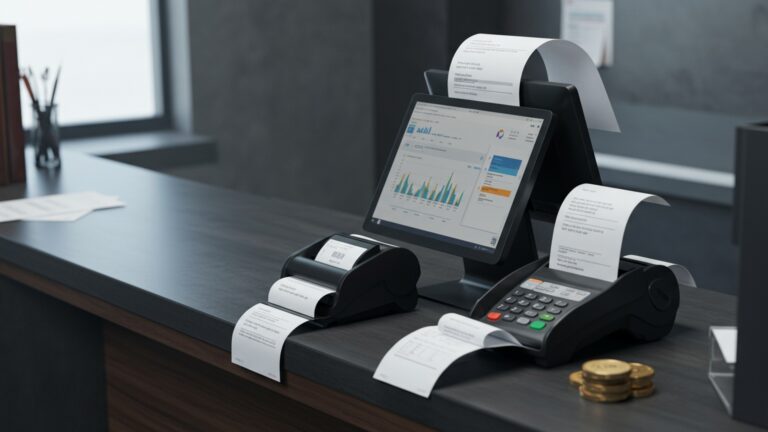How to Choose the Best Billing and POS Software for Your Business Needs
Navigating the complex landscape of modern business operations demands more than just basic transaction processing; it requires a sophisticated billing and POS software solution that acts as the central nervous system for your enterprise. In an era dominated by seamless e-commerce integration, real-time inventory management. the imperative for personalized customer experiences, selecting the optimal platform becomes a critical strategic decision. Recent advancements highlight a pivot towards AI-driven analytics, robust CRM capabilities. unified cloud-based ecosystems that transcend simple sales, enabling businesses to meticulously track customer journeys, manage recurring subscriptions. optimize supply chains. Ignoring these integrated functionalities means missing out on crucial growth opportunities and competitive advantages in today’s fast-paced market.

Understanding Billing and POS Software: The Foundation of Modern Retail
In today’s fast-paced business environment, efficient operations are paramount. At the heart of most successful retail and service businesses lies a robust system for managing sales and transactions. This system often takes the form of integrated billing and POS software. To make an informed decision, it’s crucial to comprehend what these terms mean individually and how their convergence benefits your business.
What is Billing Software?
Billing software, at its core, automates the process of generating invoices and managing financial transactions. It tracks sales, expenses. payments, ensuring accurate financial records. Historically, this involved manual entry into ledgers or basic spreadsheet programs. Modern billing software streamlines this by:
- Creating professional invoices and receipts.
- Tracking payment statuses (paid, pending, overdue).
- Managing customer accounts and credit limits.
- Generating financial reports such as sales summaries and profit/loss statements.
What is POS Software?
POS stands for “Point of Sale.” POS software is the system used by businesses to complete customer transactions. Think of the checkout counter at a grocery store, a restaurant, or a boutique – the software running that terminal is the POS. It’s designed to:
- Process sales, including item scanning, price lookup. quantity adjustments.
- Handle various payment methods (cash, credit/debit cards, mobile payments).
- Apply discounts, promotions. gift cards.
- Manage returns, exchanges. voids.
- Open and close cash drawers.
The synergy of these two systems, often referred to simply as billing and POS software, creates a powerful, all-in-one solution that not only processes sales but also manages the financial aftermath, inventory updates. customer data seamlessly.
Key Features to Look for in Billing and POS Software
When evaluating potential billing and POS software solutions, a comprehensive feature set is critical. The right software should simplify operations, enhance customer experience. provide valuable insights. Here are the essential features to prioritize:
Sales and Transaction Management
This is the core functionality. Look for software that offers intuitive interfaces for quick sales processing. Features like barcode scanning, quick item lookup, custom pricing. the ability to handle various transaction types (sales, returns, exchanges, layaways) are vital. A good system should also support split payments and custom discounts.
Inventory Management
Effective inventory control is a cornerstone of profitability. Your billing and POS software should include robust inventory features such as:
- Real-time stock tracking across multiple locations.
- Automated low-stock alerts.
- Purchase order generation and vendor management.
- Inventory counts and adjustments.
- Categorization and variants (e. g. , size, color for clothing).
- Bundle and kit creation.
Real-world example: A small electronics store, “TechHaven,” struggled with stockouts of popular headphones. By implementing billing and POS software with real-time inventory, they now receive automated alerts when stock drops below a reorder point, allowing them to replenish before losing sales. This increased their customer satisfaction and reduced lost revenue.
Customer Relationship Management (CRM)
Building strong customer relationships is key to repeat business. Integrated CRM features allow you to:
- Capture customer data (name, contact info, purchase history).
- Create loyalty programs and reward points.
- Manage customer feedback and preferences.
- Target specific customer segments with promotions.
Reporting and Analytics
Data is power. The best billing and POS software provides insightful reports that help you grasp your business performance. Look for comprehensive reports on:
- Sales trends (daily, weekly, monthly, by item, by employee).
- Peak sales times.
- Inventory turnover and best-selling products.
- Customer purchase patterns.
- Employee performance.
These analytics are crucial for making informed business decisions, optimizing stock levels. planning marketing campaigns.
Employee Management
Streamline staff operations with features like:
- User roles and permissions (e. g. , cashier, manager, administrator).
- Time clock functionality for tracking shifts.
- Sales performance tracking for individual employees.
Payment Processing Integration
Seamless integration with various payment processors is non-negotiable. Your software should support EMV chip cards, NFC (tap-to-pay), mobile payments (Apple Pay, Google Pay). traditional swipe. Ensure it offers competitive processing rates and reliable hardware compatibility.
Multi-location Support
If your business has, or plans to have, multiple locations, the software must be able to manage inventory, sales. customer data centrally across all branches. This provides a unified view of your entire operation.
Offline Mode Capability
Internet outages can cripple a business. An offline mode allows you to continue processing sales even without an internet connection, syncing data once connectivity is restored. This is a critical feature for business continuity.
Assessing Your Business Needs: A Strategic Approach
Before diving into specific software options, a thorough assessment of your unique business needs is essential. A generic solution might not fit. an over-engineered one could be costly and cumbersome. Consider these factors:
Business Type and Size
The requirements for a small coffee shop differ significantly from those of a multi-chain retail store or a full-service restaurant.
- Retail
- Restaurants/Cafes
- Service Businesses (e. g. , salons, spas)
Focus on inventory management, barcode scanning, customer loyalty programs. e-commerce integration.
Prioritize table management, kitchen display systems (KDS), menu customization, order modifiers. tip management.
Look for appointment scheduling, staff management, client history. membership options.
Small businesses might thrive with simpler, more affordable solutions, while larger enterprises will require more robust, scalable. customizable billing and POS software.
Budget Considerations
Costs can vary widely, from subscription-based models to one-time purchase licenses, plus hardware costs. Be clear about your budget for:
- Software licensing/subscription fees.
- Hardware (POS terminals, barcode scanners, receipt printers, cash drawers).
- Payment processing fees.
- Installation, training. ongoing support.
Always consider the total cost of ownership (TCO) over several years, not just the initial outlay.
Scalability Requirements
Will your business grow? Choose billing and POS software that can grow with you. This means supporting more users, more locations, increased transaction volumes. additional features as your business expands. Migrating to a new system later can be costly and disruptive.
Specific Industry Needs
Certain industries have unique compliance or operational requirements:
- Cannabis dispensaries
- Pharmacies
- Food service
Seed-to-sale tracking, age verification, state compliance reporting.
Prescription management, insurance billing, controlled substance tracking.
Recipe management, ingredient tracking, allergen data, online ordering integration.
Ensure the software you choose explicitly addresses these niche needs.
Existing Systems Integration
Do you already use accounting software (like QuickBooks or Xero), an e-commerce platform (like Shopify), or a separate CRM? Your new billing and POS software should ideally integrate seamlessly with these existing tools to avoid data silos and manual data entry, which can lead to errors and inefficiency.
Deployment Options: Cloud-Based vs. On-Premise
The choice between cloud-based and on-premise billing and POS software is fundamental and impacts everything from cost to accessibility and security. Understanding the differences is crucial.
Cloud-Based (SaaS – Software as a Service)
Cloud-based solutions are hosted by the vendor on their servers and accessed via the internet through a web browser or app. They typically operate on a subscription model.
- Pros
- Cons
Lower upfront cost, accessible from anywhere with an internet connection, automatic updates and backups, vendor handles maintenance and security patches, rapid deployment.
Dependent on internet connectivity (though many offer offline modes), ongoing subscription fees, less customization flexibility, data stored on third-party servers.
On-Premise
On-premise software is installed and run directly on your own computers and servers within your business location. You own the software license.
- Pros
- Cons
Full control over data and customization, no reliance on internet for core functionality, potentially lower long-term costs (after initial investment).
High upfront cost for software and hardware, requires in-house IT expertise for maintenance, updates. security, not easily accessible remotely, data backups are your responsibility.
Comparison Table: Cloud-Based vs. On-Premise Billing and POS Software
| Feature | Cloud-Based (SaaS) | On-Premise |
|---|---|---|
| Initial Cost | Low (subscription fees) | High (license, hardware, setup) |
| Maintenance & Updates | Handled by vendor | Managed by business (IT staff) |
| Accessibility | Anywhere with internet | Limited to business network |
| Data Control | Vendor manages | Full control by business |
| Scalability | Easily scalable | Requires hardware upgrades |
| Security | Vendor responsible (often high-level) | Business responsible (depends on internal expertise) |
| Internet Dependency | High (though many have offline modes) | Low (for core functions) |
Use Case: A brand new boutique, “Urban Threads,” chose a cloud-based billing and POS software because of its lower upfront costs and the ability for the owner to manage inventory and sales reports from her home office. In contrast, a large grocery chain with established IT infrastructure and a need for highly customized integrations might opt for an on-premise solution to maintain full data control and specific security protocols.
Integration Capabilities: Connecting Your Business Ecosystem
The true power of modern billing and POS software lies in its ability to integrate with other business tools. A standalone system, no matter how good, creates data silos and requires manual data transfer, leading to inefficiencies and errors. Look for solutions that offer robust integration with the following:
Accounting Software
Seamless integration with accounting platforms like QuickBooks, Xero, or Sage is paramount. This automatically syncs sales data, expenses. payment details, eliminating manual data entry, reducing errors. providing a real-time, accurate financial picture. This integration is a huge time-saver during tax season.
// Example of an API call for sales data integration (conceptual)
POST /api/v1/accounting/sales_entry
Headers: { Authorization: "Bearer [Your_API_Key]" }
Body: { "date": "2023-10-27", "total_amount": 150. 75, "tax_amount": 10. 25, "payment_method": "Credit Card", "invoice_number": "INV-00123", "items": [ {"product_id": "P001", "quantity": 2, "unit_price": 25. 00}, {"product_id": "P005", "quantity": 1, "unit_price": 90. 50} ]
}
E-commerce Platforms
If you sell online (or plan to), integration with platforms like Shopify, WooCommerce, or Magento is crucial. This ensures unified inventory management, so online and in-store stock levels are always accurate. It also centralizes customer data and sales reporting, providing a holistic view of your sales channels.
CRM Systems
While many billing and POS software solutions have built-in CRM, advanced businesses might use a dedicated CRM like Salesforce or HubSpot. Integration ensures that all customer interactions, purchase history. loyalty data are synchronized, allowing for more personalized marketing and customer service.
Marketing Tools
Connecting with email marketing platforms (Mailchimp, Constant Contact) or SMS marketing services allows you to leverage customer purchase data for targeted promotions, loyalty program updates. personalized communications. For instance, sending a discount code to customers who haven’t visited in a while.
Payment Gateways
While often part of the POS itself, understanding the payment gateway options is crucial. Ensure the system integrates with reliable, secure. cost-effective payment processors that support your preferred hardware and payment types. Some software might be tied to a specific payment processor, which could limit your options or increase fees.
Security and Compliance: Protecting Your Data and Your Customers
In an era of increasing cyber threats and stringent data privacy regulations, the security features of your billing and POS software are non-negotiable. Protecting your business and your customers’ sensitive details is paramount.
PCI DSS Compliance
The Payment Card Industry Data Security Standard (PCI DSS) is a set of security standards designed to ensure that all companies that process, store, or transmit credit card details maintain a secure environment. Any billing and POS software handling credit card transactions must be PCI DSS compliant. This involves:
- Building and maintaining a secure network.
- Protecting cardholder data.
- Maintaining a vulnerability management program.
- Implementing strong access control measures.
- Regularly monitoring and testing networks.
- Maintaining an data security policy.
Always verify the vendor’s PCI compliance status. Using a non-compliant system can result in severe fines and reputational damage in the event of a data breach.
Data Encryption
Ensure that all sensitive data, especially customer payment details and personal details, is encrypted both in transit (when it’s being sent between your POS, payment processor. cloud servers) and at rest (when it’s stored on servers). Look for industry-standard encryption protocols like TLS (Transport Layer Security) for data in transit and strong AES (Advanced Encryption Standard) for data at rest.
User Access Controls
Robust user access controls prevent unauthorized access to sensitive functions and data. The software should allow you to create different user roles (e. g. , cashier, manager, administrator) with specific permissions. For example, a cashier might only be able to process sales, while a manager can handle refunds and access sales reports. This minimizes internal fraud and errors.
Backup and Recovery
Data loss can be catastrophic. Your billing and POS software should have a reliable data backup and recovery strategy. For cloud-based solutions, the vendor is typically responsible for this, performing regular, automated backups. For on-premise systems, you’ll need to establish your own robust backup protocols, including offsite storage. Inquire about the vendor’s disaster recovery plan and how quickly data can be restored in an emergency.
Expert Insight: “Data security isn’t just a feature; it’s a responsibility,” advises Sarah Chen, a cybersecurity consultant specializing in retail systems. “Businesses often overlook the importance of robust encryption and PCI compliance until it’s too late. Always prioritize vendors who demonstrate a clear commitment to data protection.”
Vendor Support and Training: A Crucial Long-Term Partnership
Investing in billing and POS software is not just about the technology; it’s about forming a relationship with a vendor. The quality of support and training can significantly impact your day-to-day operations and your ability to leverage the software effectively.
Customer Support Channels
Consider the availability and quality of customer support. What channels are offered (phone, email, live chat, knowledge base)? Is support available 24/7, or only during business hours? For businesses operating outside standard office hours, 24/7 support can be a lifesaver when a critical issue arises during a busy shift. Look for vendors with quick response times and knowledgeable support staff.
Training Resources
Even the most intuitive software requires some training. Evaluate the training resources provided by the vendor:
- Onboarding
- Documentation
- Tutorials
- Live Training
Is there a structured onboarding process to help you get started?
Are there comprehensive user manuals, FAQs. online guides?
Does the vendor offer video tutorials or webinars?
Are live training sessions (online or in-person) available, especially for complex features or new staff?
A well-trained team will be more efficient, make fewer errors. be more satisfied with the system.
Update and Maintenance Policies
Software evolves. grasp how the vendor handles updates and maintenance. For cloud-based solutions, updates are usually automatic and seamless. For on-premise, inquire about the frequency of updates, how they are deployed. whether they involve additional costs. Also, ask about their bug fix policy and how quickly critical issues are addressed. A vendor committed to continuous improvement will regularly release new features, security patches. performance enhancements.
Making the Final Decision: A Step-by-Step Guide
Choosing the right billing and POS software is a significant decision that will impact your business for years to come. By following a structured approach, you can make an informed choice that aligns perfectly with your operational needs and strategic goals.
1. Shortlist Potential Solutions
Based on your assessed needs, desired features, budget. deployment preferences, create a shortlist of 3-5 vendors. Utilize online reviews (e. g. , Capterra, G2), industry publications. recommendations from peers. Focus on vendors that specialize in your industry or have a strong track record with businesses of your size.
2. Request Demos and Free Trials
This is a critical step. Don’t rely solely on marketing materials. Request personalized demonstrations from each shortlisted vendor. During the demo, ask specific questions related to your unique pain points and workflows. Ideally, follow up with a free trial period where you and your team can get hands-on experience with the software. Test key functionalities like sales processing, inventory adjustments. report generation in a real-world simulation.
Actionable Takeaway: During your demo, prepare a script of common scenarios your business faces. For a restaurant, this might be “How do I split a bill for a table of 4?” or “How do I apply a discount to a specific item?” For retail, “How do I process a return without a receipt?” or “How do I check inventory levels at another store location?”
3. Read Reviews and Testimonials
Go beyond the vendor’s website. Look for independent reviews on trusted platforms. Pay attention to feedback regarding customer support, ease of use, reliability. specific features that are vital to you. Case studies from similar businesses can also provide valuable insights into real-world applications of the billing and POS software.
4. Consult with Industry Peers
Reach out to other business owners in your industry, especially those with similar operations. Their firsthand experiences, both positive and negative, can offer invaluable perspectives that marketing materials won’t. They might highlight hidden costs, integration challenges, or unexpected benefits.
5. Negotiate Pricing and Terms
Once you’ve narrowed down your choice, don’t hesitate to negotiate. Inquire about package deals, annual discounts, or introductory offers. Clarify all costs, including software licenses, hardware, payment processing fees, installation, training. ongoing support. Ensure all terms and conditions, including contract length and cancellation policies, are clearly understood before signing any agreement.
Conclusion
Choosing the ideal billing and POS software is a strategic investment, not merely a purchase. It demands a clear understanding of your business’s unique rhythm and future aspirations. Remember, the market is constantly evolving; the rise of cloud-based solutions and AI-driven analytics, for instance, now offers unprecedented real-time insights and flexibility. From my own experience advising a multi-location café, I witnessed firsthand how thorough trial periods revealed specific inventory tracking needs that generic demos completely missed. Therefore, actively test prospective systems with your actual operational workflows, rather than just passively reviewing features. This proactive approach ensures seamless integration and prevents costly mismatches down the line, empowering you to truly optimize your business, much like understanding how to integrate for maximum profit. Embrace this decision as an opportunity to future-proof your operations, allowing you to focus on growth and delivering exceptional customer experiences.
More Articles
Discover How to Optimize Your Business with Smart POS Billing Software
Learn How Cloud Based POS Software Boosts Business Efficiency
A Comprehensive Guide to Mastering Essential POS Software Features
How to Choose the Best POS Software in India for Your Business
How to Streamline Restaurant Operations with Effective POS Software
FAQs
What’s the first step in picking the right billing and POS software?
Start by figuring out what problems you need to solve. Are you just trying to process sales faster, or do you also need to manage inventory, track customer loyalty, or integrate with online orders? Make a list of your absolute must-have features first, then your nice-to-haves. This helps narrow down your options significantly.
How do I know if I need a basic system or something with more bells and whistles?
Think about your current pain points and where you see your business in the next few years. If you’re a small shop just needing quick sales and basic reporting, a simpler system might be perfect. But if you plan to grow, manage detailed inventory, offer gift cards, integrate with e-commerce, or run extensive reports, you’ll definitely need a more robust and scalable solution that can grow with you.
Are there any essential features I really shouldn’t overlook?
Absolutely! Make sure it offers easy-to-use sales processing, solid inventory management, a way to track customer info (CRM). basic reporting so you can see how you’re doing. Depending on your business, you might also need employee management, multi-location support, loyalty programs. easy integration with payment processors or accounting software.
Should I go for cloud-based or an installed software system?
Cloud-based (SaaS) systems are super popular these days. You access them via the internet, often pay a monthly fee. don’t have to worry about maintenance or updates – the provider handles all that. Installed (on-premise) software runs on your own computers, giving you more control but also requiring you to manage updates and backups yourself. Cloud is great for flexibility; on-premise for deep control if you have the tech know-how.
How essential is it for the software to play nice with other tools I use?
It’s a huge deal! If you already use accounting software like QuickBooks, an e-commerce platform like Shopify, or specific payment gateways, check if the POS software integrates smoothly with them. This saves you a ton of manual data entry, prevents errors. keeps all your business operations running like a well-oiled machine.
What should I consider regarding the overall cost?
Don’t just look at the upfront price tag. Factor in recurring costs like monthly or annual subscription fees, any necessary hardware (POS terminals, printers, scanners), payment processing fees. potential costs for setup, training. ongoing support. Make sure the total cost aligns with your budget and offers good value for the features you’re getting.
What kind of customer support should I expect after choosing a system?
Look for reliable support channels like phone, email, or live chat, especially during your peak business hours. It’s also great if they offer training resources, a comprehensive knowledge base, or even dedicated account managers. Good support can be a real lifesaver when you hit a snag or need help optimizing your new system.






